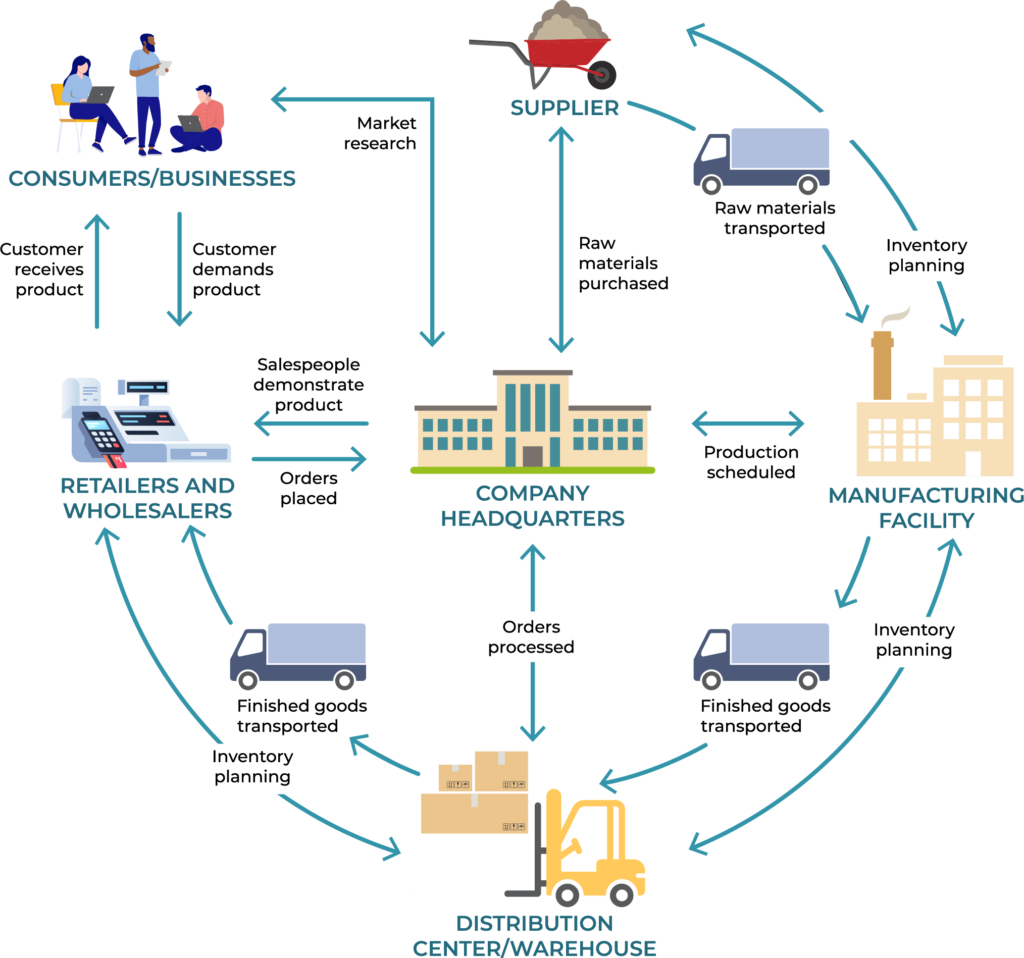We may have finally reached a tipping point when it comes to action on climate change. 1 Energy companies, manufacturing companies, and governments around the world are setting realistic goals and, more importantly, taking real action.
Today’s blog is about how climate action relates to supply chain management. Almost every company these days has a sustainability page on their website. Some use the term circularity. You can think of circularity as a subset of sustainability. Sustainability refers to safer, greener, more responsible operations as they relate to people, the planet, and profits (i.e., the triple bottom line (TBL)2). Circularity does this as well but focuses on the resource cycle and waste specifically. The Circular Supply Chain Network describes circular supply chains as “interconnected systems that use secondary and regenerative inputs to generate value by reducing and extending resource use.”
Change is coming in many forms including ethical sourcing, less toxic ingredients, LEED buildings, and carbon offsets. These sustainable practices are lauded and proving to not only be the right thing to do for the planet, but also for the pocketbook. We know that companies that embrace sustainability and circularity are outperforming traditional business models more and more. It is no longer something to do just to look good or be nice; it is financially better as well. According to Forbes, “…‘doing right’ and doing well by shareholders are not mutually exclusive.”
Supply chain management lies at the heart of our efforts because making stuff is the heart of the problem, exacerbating the challenges of too much plastic, fossil fuels, transportation, waste, and electricity (Sources of Greenhouse Gas (GHG) Emissions | US EPA.) Fortunately, what lies at the heart of successful supply chain management is integration, efficiency, and leanness, which align perfectly with the notions of sustainability and circularity. So, it should be easy to put these concepts together into a better framework for the future.
There are many ways to move your business to a more sustainable and circular mindset. Every company has some low-hanging fruit. However, achieving full-scale sustainability and circularity cannot happen without end-to-end alignment, hierarchical connectivity, integration of all parts of your supply chain (forward and reverse), performance metrics, and business processes. And this alignment needs to be part of your existing supply chain before you can take it to the next level.

Have You Ever…?
- Developed a supply plan just to find out your plants do not have the capacity to meet it?
- Found that the folks in the factory want to make stuff there is no demand for?
- Set minimum inventory levels only to find out you do not have the warehouse space to store that amount of product?
- Handed down inventory targets to plants that are rewarded for high utilization rates, so they instead make what gives them the best utilization?
- Instituted a corporate strategic supply chain plan having never met your tactical supply chain planning team?
I’ve seen these things first-hand, and it is what happens when you do not have an integrated supply chain planning process and system. It is no better than a game of Whack-A-Mole: You knock out one problem just to create another.
To achieve true integration, define your KPIs to serve corporate goals (and each other!), design your processes to be in sync, and deploy planning systems that use optimization tools… in that order. Once you have mastered the practice of supply chain integration in the traditional sense, it is much easier to take it to the next level – sustainability & circularity.
How to Achieve Fully Sustainable Circular Integration
- Set appropriate KPIs
- Sustainable: Triple Bottom Line (TBL), 17 Sustainable Development Goals2.
- Circular: Zero Waste.
- Product Design
- Sustainable: ethical sourcing, less virgin raw materials, less harmful chemicals, less packaging, less plastic.
- Circular: Extend the lifespan of your products by making repairs easy, longer seasons, product buy-back & reuse of components.
- Process Design
- Sustainable: Better inventory mobility, blockchain, and AI to improve visibility and integrity.
- Circular: Reverse logistics, the secondary market for unused material & by-products, repair.
- Consider Externalities
- Sustainable: Greenhouse gases (GHG), ethical sourcing, natural resource depletion.
- Circular: Cost/penalty on waste, energy, and packaging.
To begin thinking about transitioning to a circular supply chain, consider these 7 Phases of a Circular Supply Chain:

- Identify Waste – Measure as a ratio of material into material out.
- Intensify the Circles – Maximize material utilization.
- Narrow the Circles – Reduce the number/amount of resources needed (e.g., Kaizen, Lean manufacturing.)
- Predict – Determine when, where, how, and what resources are ready for others across the supply chain network.
- Slow the Circles – Extend the life of your products.
- Close the Circles – Defines the ability to source only secondary or regenerative materials.
- Capture the Circles – Locate and transform secondary materials (e.g., ocean plastics, product takebacks).
Circular supply chains are small supply chains, where waste is not waste; it is a resource. Duvel Moortgat, Lavazza, and Ontex are a few of Arkieva’s customers that are great examples of circular supply chains.
For companies like these that have embraced sustainability and circularity, what is the next step? It is integrating these practices with the way you manage and plan your supply chains.
How to Incorporate Circularity Into Your Supply Chain Planning
- Demand Planning
- Demand forecasting for spare parts as companies embraces product repair.
- Demand forecasting for refurbished products vs. new end products.
- Promotion of refurbished and pre-owned products.
- Supply Chain Planning
- Reverse logistics for repair/re-use, product take-back, and reusable packaging.
- Tracking packaging, waste, and energy use as separate activities with separate costs so they can be part of the overall cost structure.
- Include revenue from selling downstream by-products and waste.
- Models that use triple bottom line metrics.
- Supply Chain Design
- Strategic models to explore the impact of the use of alternative (more ethical and sustainable) raw materials.
- Price, availability, cost, BOMs, equipment changes, demand.
- Strategic and tactical models to explore trade-offs of virgin plastic vs. recycled plastic.
- Models that use triple bottom line metrics.
- Strategic models to explore the impact of the use of alternative (more ethical and sustainable) raw materials.
The tools already exist. All you must do is extend the model you are already using… and embrace your inner tree-hugger!
1 How did we get here?
We have long been aware that waste and pollution are problems for the health of our environment. The Modern Environmental Movement arguably began in the mid-1950s. States and local communities began to enact laws to fend off the damage, with marginal success. The 1962 publication of Rachel Carson’s “Silent Spring,” exposing the dangers of pesticides, was a watershed event. Repeated fires on the Cuyahoga River in Ohio and the Santa Barbara oil spill in 1969 were just two of the more egregious events that finally led President Nixon to establish the Environmental Protection Agency (EPA) in 1970, the same year as the first Earth Day.
By the 1980s, the movement had stalled, and while advancements and awareness continued to grow in fits and spurts, things were getting worse, not better. Policies, bans, and regulations have not kept up with the growing demand on and depletion of our natural resources. Today, the externalities of the industrialization and technology advancements of the last 100 years are becoming harder to ignore.
2 Sustainable Performance Metrics
Traditionally, the bottom line is a financial concept, i.e., profits. Triple Bottom Line (TBL) considers performance with respect to social and environmental indicators as well. The easiest way to remember it is people-profit-planet. Sustainable companies consider the well-being of not only their customers, but their employees and society as a whole (people). In addition, they consider the impact their operations have on the climate and our natural resources (planet). In 2015, the UN developed a set of 17 Sustainable Development Goals that are considered the benchmark for developing and measuring sustainability initiatives.





